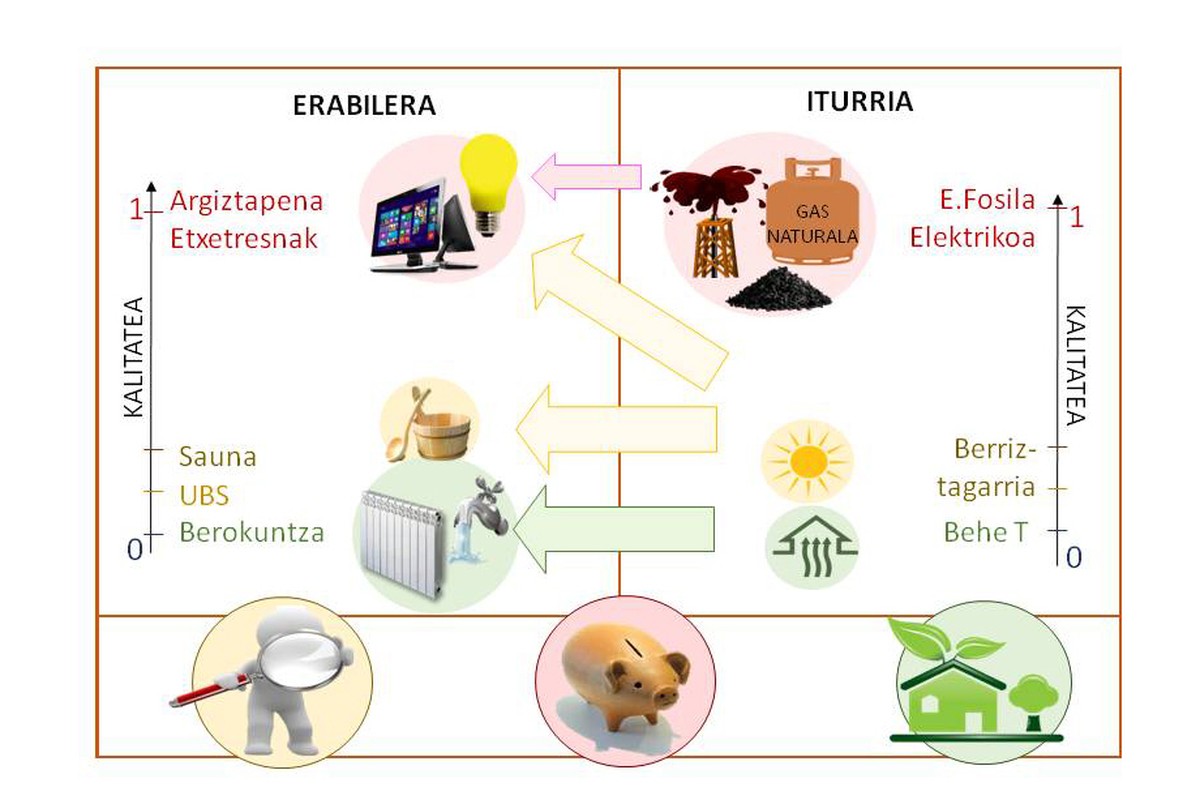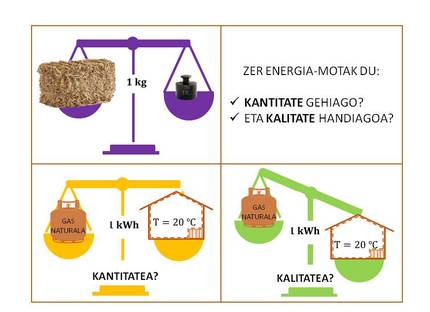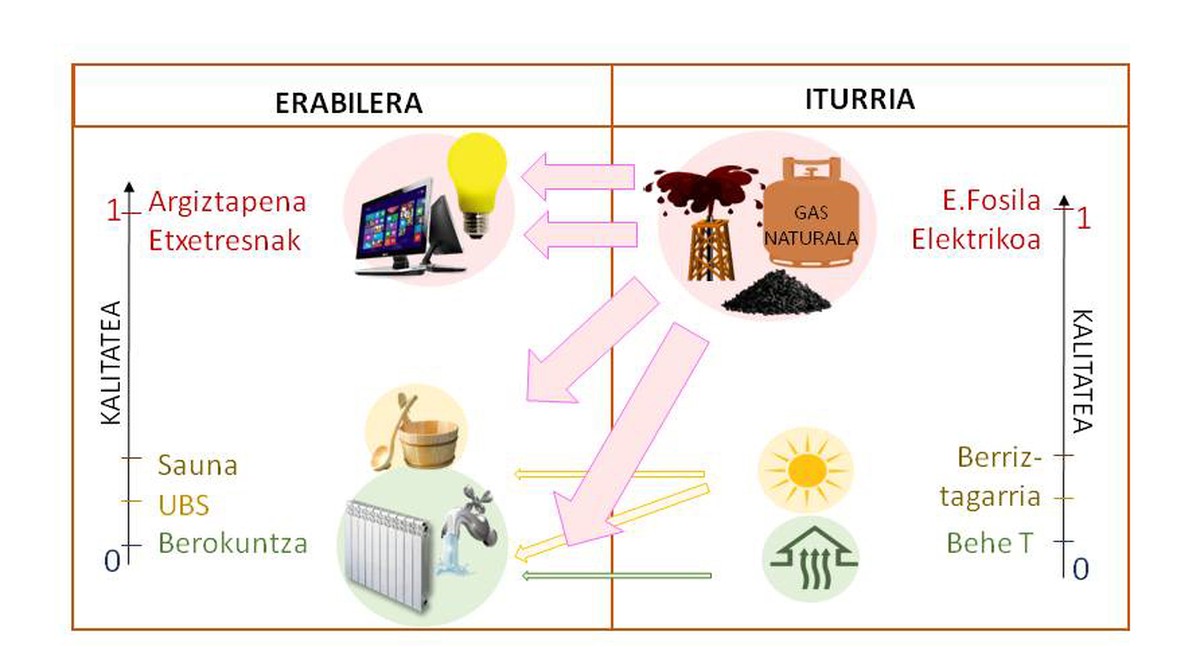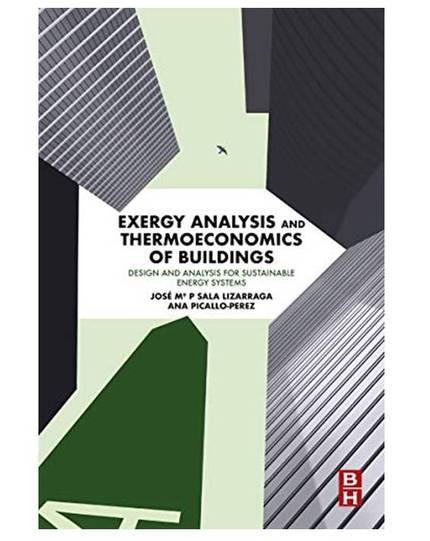Exergia: tool to promote energy efficiency in buildings
2020/10/12 Ana Picallo Perez - ENEDI ikerketa-taldeaEnergia Ingeniaritza Saila (EHU) | José M. Sala Lizarraga - ENEDI ikerketa-taldeaEnergia Ingeniaritza Saila (EHU) | Eider Iribar Solaberrieta - Eraikuntza Kalitatearen Kontrolerako LaborategiaEusko Jaurlaritza Iturria: Elhuyar aldizkaria

What is heavier 1 kg of straw or 1 kg of iron? Many know that if the unit of weight is kg they will weigh the same. We ask you if the energy unit is kWh, where is more energy in a 1 kWh natural gas tank or in a 1 kWh hot air room? In both containers there is the same amount of energy, but what type of energy is most useful from the point of view of quality?
A flow of energy, in addition to having a quantity of energy, has a quality, that is, a useful working capacity, for example: lighting a light, air conditioning a stay or moving a car. Then, the chemical energy capacity of 1 kWh stored in a container of natural gas is higher than the thermal energy of 1 kWh in an air mass at 20 °C; in short, a series of works can be obtained with the use of the chemical energy of natural gas (air conditioning, mechanical work, ignition of a bulb, etc. ). ), but with the thermal energy of the air it is only possible to air, although in quantitative terms both have an energy of 1 kWh (see figure 1).
The energy demand of buildings presents high levels of quality. On the one hand, electricity is consumed, such as lighting, appliances, elevators, etc. On the other hand, the supply of sanitary hot water and the satisfaction of the demands of heating and cooling is usually carried out through high quality energies such as natural gas (chemical energy). However, since the demand for heating or cooling is satisfied with low quality energy (thermal energy), the final energy quality does not conform to the quality of demand (see figure 2).
So far, although most energy systems have been designed quantitatively, they should be designed taking into account the quality (that is, the exergia), with the benefits that it entails. In addition, in addition to promoting energy efficiency, it is necessary to incorporate the environmental aspect to achieve energy systems with less environmental impact, that is, to promote sustainability.
The aim of this work is to reflect on the benefits of applying the concept of exergy in the field of buildings. The promotion of energy efficiency and the sustainability of buildings is fundamental taking into account the high energy consumption of the sector and its potential for improvement.
What is exergy?
The exergia represents the capacity of an energy to transform into work. Some forms of energy can be transformed entirely, for example, into electrical energy where all energy is exergia. However, there are other forms of energy such as heat, in which only a part can become work, so that the exergy flow is only a part of a heat flow [1].
On the other hand, the capacity to transform energy into work corresponds to the degree of imbalance of energy with the environment. For example, while the internal energy of a lake's water is enormous, its potential for generating work is null. The farther away from the environment, the greater the capacity to transform into work. Therefore, a mass of hot water at 60ºC presents a greater exergia than if it is at 40ºC, since it is further away from the ambient temperature.
These quality ideas are reflected in the second principle of thermodynamics: although energy is not produced or destroyed (the first principle of thermodynamics), the quality of this energy is less and more irreversible. This loss of quality is related to the imperfections of equipment and processes, being called irreversibility or destruction of exertions.
How do the concepts exergia and economy marry?
Our society needs more and more energy, but natural resources are limited. Consequently, it is essential for the improvement of systems to understand the mechanisms of degradation of energy and resources and to develop systematic procedures to reduce their environmental impact. If we combine exergic analysis with the economy, we obtain a powerful tool for analysis and optimization of systems called exergoeconomics [2].
Being the exergia a useful energy for society, it has economic value and we must take care of it. When we pay for energy consumption, we are actually paying for its availability, that is, its exaggeration. Therefore, exergy is a rational basis to evaluate the resources, processes, equipment and efficiencies of systems and to evaluate the costs of systems products.
How do the concepts exergia and environment marry?
Almost all the energy (and, therefore, the exergia) reaches the terrestrial surface from the Sun. The exergia absorbed by the Earth is gradually destroyed, but in this destruction the cycles of water, wind and soil life are managed. The plants absorb the exergia of the sun and make it a chemical exergia through photosynthesis. Through the food chain, this chemical exergia passes through organisms in ecosystems.
On the other hand, energy and environmental problems are currently notorious, such as global warming, air pollution, surface and underground water pollution, solid waste, soil degradation, etc. However, instead of associating this degradation to energy, it must be associated with exergy.
The exergian analysis is a powerful tool to perform processes and installations more efficient and, at the same time, reduce the consumption of resources (exergia) and therefore reduce the generated waste. Therefore, the use of exergative methods implies an adequate assessment of air pollution, liquid or solid discharges, etc., a discipline called environmental economy (exergoenvironmics) [3].
How are the concepts of exertion and sustainability married?
The sustainable development of society and, in particular, of the construction sector involves the sustainable provision of natural resources. The limitation of most natural goods obliges its efficient use to maintain them in a longer period of time. In addition, the mineral can be considered an exergy vector: a mineral deposit contrasts with the environment, and the greater the concentration of the mineral, the greater the contrast and greater the potential of work (exergia).
Taking into account these ideas, the exergative analysis allows to analyze the degree of efficiency of a society and the balance in the consumption of its physical resources. In this way, it is possible to compare world societies and analyze the international system if we want to distribute resources in a more just way in the world.
The application of energy in buildings encourages energy efficiency
The construction sector is closely related to the consumption of natural resources and emissions to the atmosphere. If we analyze buildings throughout their life cycle (construction, use and demolition), they reduce the ozone layer due to the use of different chemicals. They also contribute to climate change due to high CO2 emissions both during the construction phase and during the service life.
The exergic analysis is of great utility both for the study and for the design of the systems of the buildings and of the whole of the building. As has already been mentioned, when considering the qualitative aspect of energy (energy quality), information is obtained on the adequacy of the energy used and energy demand. Thus, low quality energy sources, such as waste heat, can be used to meet low quality demands such as air conditioning. Therefore, the minimum consumption of exergy required to meet demand is quantified (see Figure 3. For this reason, the exergy powers energy efficiency and renewable sources.
In addition, the losses of exergia along the energy chain are quantified and the potential for energy improvement, which is not possible to obtain with energy analyses, is revealed. On the other hand, it provides a common base to compare the energy efficiency of the systems and installations of buildings. In this way it is possible to compare with the exergia the heat of the combustion fuel of a boiler and the solar gain of a window.

The losses and destruction of exertion identify the places and causes of the ineffectiveness of a system. This facilitates decision-making for the application of improvement measures.
Although the exergic analysis is interesting, a few years ago it began to study its application in buildings. For some professionals it may be complex and, unfortunately, calculations of exergative methods seem annoying, and their results, sometimes, can be difficult to interpret or understand.
In addition, the exergian analysis reveals the low exergic yields of conventional systems. For example, if a conventional gas boiler has an energy yield of 85-90%, its energy performance is 18-20%. In fact, with the exergian analysis it stands out that some of the processes and systems used are usually basically wrong, which can go against the interests of some.
Consequently, the exergia is a variable of great meaning
This paper presents the key ideas for the application of exergological analysis in buildings, both from an energy and economic and environmental point of view.
The exergic analysis is used to analyze the behavior of buildings, in order to accurately quantify the losses. This information, essential for the promotion of energy efficiency and the best use of resources, is only possible through the application of the second law of thermodynamics. All these characteristics make exergia a good tool to promote sustainability in the field of engineering and architecture.
Consequently, it is necessary to have detailed models of exergonomic analysis and calculation methodologies specifically designed in buildings, in order to update the concept and use it by professionals of the sector, aim of the recently published book “Exergic analysis and thermoeconomy in buildings: analysis and design of sustainable energy systems” [4] (see figure 4).
BIBLIOGRAPHY BIBLIOGRAPHY
1 Picallo, A., Escudero, C., Flowers, I., Room, J. M. M. 2016 Symbolic thermoeconomics in building energy supply systems. Energy and Buildings, 127, 561-570.
2 Picallo-Perez, A., Hall, J. M. M. Tsatsaronis, G., Sayadi, S. 2020. Advanced Exergy Analysis in the Dynamic Framework for Assessing Building Thermal Systems. Entropy, 22(1), 32.
3 Dincer, I., Rosen, M. A. A. Al-Zareer, M. 2018. 1.9 Exergoenvironmental Analysis. Comprehensive Energy Systems, 377.
4 Sala-Lizarraga, J. M. M. Picallo-Perez, A. 2019.Exergy Analysis and Thermoeconomics of Buildings: Design and Analysis for Sustainable Energy Systems. Butterworth-Heinemann.

Gai honi buruzko eduki gehiago
Elhuyarrek garatutako teknologia







